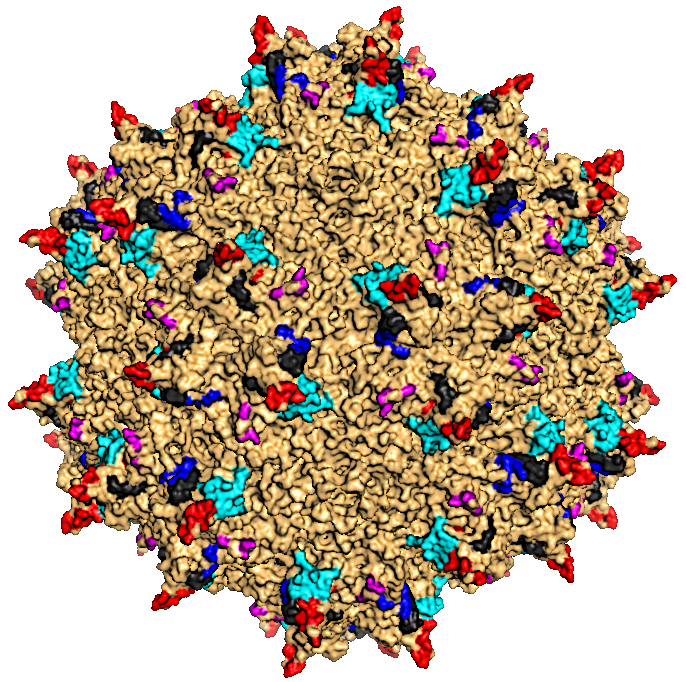
Gene therapy is on the verge of revolutionizing human medicine. Adeno-associated virus (AAV) is currently the most successful viral vector but it suffers from limitations preventing it from unleashing the full potential of gene therapy. High doses are often needed to reach therapeutic effect, due to poor transduction of the target cells or to excessive loss to off-target tissue. Unfortunately, high doses increase the risk of serious adverse effects, in addition to contributing to the high cost of gene therapy. Another major concern is the high prevalence of neutralizing antibodies (NAB) against many AAV serotypes in human populations, resulting in patients being excluded from gene therapies they would otherwise benefit from. Capsid engineering, using rational design, directed evolution or a combination of both, addresses these issues, generating novel capsids that are better suited for human gene therapy.
Nowadays, most capsid engineering is performed by directed evolution using capsid libraries in which a random peptide is inserted at a fixed position of the capsid surface that is known to tolerate insertions (usually in variable region VIII). This approach can be quite successful for improving tissue specificity, as shown by the retinal capsid AAV2.7m8 or the myotropic capsid AAVMYO for example. Another popular method to create capsid libraries is DNA shuffling, in which naturally-occurring capsid genes are fragmented and allowed to recombine randomly to generate chimeric capsids. One successful example is AAV-LK03, a widely used liver-targeting capsid.
However, none of these two approaches has been successful at generating capsids capable of significantly evading preexisting neutralizing antibodies. Our own method, on the other hand, does it spectacularly.
We have been pioneering a unique method of designing and constructing capsid libraries, much more technically challenging than the two methods described above and capable of delivering novel capsid variants with remarkable properties. It consists of introducing mutations on a massive scale over a wide range of the capsid surface, disrupting epitopes and profoundly altering tropism.


The two plots above illustrate immune evasion properties of 2 sets of capsid variants, retina-targeted on the left and liver-targeted on the right. They show how increasing amounts of IVIG (pool of intravenous immunoglobulins from thousands of donors) inhibit transduction of test cells (shown as decreasing GFP fluorescence). We can see that evolved capsids AAV2.7m8 (left, shown as 7m8) and AAV-LK03 (right, shown as LK03), perform only marginally better than their parent capsid AAV2 and AAV3B respectively, while the capsids derived from our latest libraries, retinal capsid 2-AD and 4-AD (left) and liver capsids P-LI1, P-LI2 and P-LI3 (right) show exceptional immune evasion.
Relevant publications
P. Kellish, D. Marsic*, S. Crosson, S. Choudury, M. Scalabrino, C. Stranf, J. Hill, K. McCullough, J. Peterson, D. Fajardo, S. Gupta, V. Makal, O. Kondratov, L. Kondratova, S. Iyer, C. Whitherspoon, P. Gamlin, S. Zolotukhin, S. Boye, and S. Boye, “Intravitreal injection of a rationally designed AAV capsid library in non-human primate identifies variants with enhanced retinal transduction and neutralizing antibody evasion,” Molecular Therapy, Oct. 2023.
D. Marsic, “Expanding Patient Access to Gene Therapies through AAV Capsid Engineering,” Pharma’s Almanac, Feb. 6, 2023.
J. Rana, D. Marsic*, C. Zou, M. Melero, X. Li, Kondratov, N. Li, Y. de Yong, S. Zolotukhin, and M. Biswas, “Characterization of a bioengineered AAV3B capsid variant with enhanced hepatocyte tropism and immune evasion,” Human Gene Therapy, Mar. 2023.
D. D. Patel, D. Marsic*, R. Periasamy, S. Zolotukhin, and D. M. Lipinski, “Identification of Novel Retinal Pericyte-Targeting rAAV Vectors Through Directed Evolution,” Translational Vision Science and Technology, vol. 11, no. 8, pp. 28–28, Aug. 2022.
D. Marsic, “Parent-map: Analysis of parental contributions to evolved or engineered protein or DNA sequences,” Journal of Open Source Software, vol. 6, no. 57, p. 2864, Jan. 2021.
M. Biswas, D. Marsic*, N. Li, C. Zou, G. Gonzalez-Aseguinolaza, I. Zolotukhin, S. Kumar, J. Rana, J. Butterfield, O. Kondratov, Y. de Jong, R. Herzog, and S. Zolotukhin, “Engineering and in vitro selection of a novel AAV3B variant with high hepatocyte tropism and reduced seroreactivity,” Molecular Therapy Methods & Clinical Development, Dec. 2020.
O. Kondratov, D. Marsic, S. Crosson, H. Mendez-Gomez, O. Moskalenko, M. Mietzsch, R. Heilbronn, J. Allison, K. Green, M. Agbandje-McKenna, and S. Zolotukhin, “Direct head-to-head evaluation of recombinant adeno-associated viral vectors manufactured in human versus insect cells,” Molecular Therapy, Dec. 2017.
D. Markusic, T. Nichols, E. Merricks, B. Palaschak, I. Zolotukhin, D. Marsic, S. Zolotukhin, A. Srivastava, and R. Herzog, “Evaluation of engineered AAV capsids for hepatic factor IX gene transfer in murine and canine models,” Journal of Translational Medicine, May 2017.
B. Palaschak, D. Marsic, R. Herzog, S. Zolotukhin, and D. Markusic, “An immune-competent murine model to study elimination of AAV-transduced hepatocytes by capsid-specific CD8+ T cells,” Molecular Therapy Methods & Clinical Development, Jun. 2017.
D. Marsic and S. Zolotukhin, “Altering tropism of rAAV by directed evolution,” Methods in Molecular Biology, vol. 1382, pp. 151–173, 2016.
D. Marsic, H. R. Mendez-Gomez, and S. Zolotukhin, “High-accuracy biodistribution analysis of adeno-associated virus variants by double barcode sequencing,” Molecular Therapy Methods & Clinical Development, vol. 2, p. 15 041, 2015.
D. Marsic, L. Govindasamy, S. Currlin, D. M. Markusic, Y.-S. Tseng, R. W. Herzog, M. Agbandje-McKenna, and S. Zolotukhin, “Vector design tour de force: Integrating combinatorial and rational approaches to derive novel adeno-associated virus variants,” Molecular Therapy, vol. 22, no. 11, pp. 1900–1909, 2014.
* : co-first author




